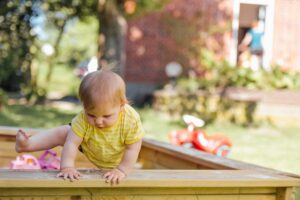
Now that you understand why parent involvement is important to ABA therapy, it’s time to talk about what an ABA therapist can do to build rapport with the families they support, and why establishing a quality working relationship is so important to therapy outcomes.
What Does Building Rapport Mean in ABA Therapy?
When thinking about your first ABA therapy session with a new client, you may be feeling overwhelmed by all the amazing things you’re going to have the chance to work on. Don’t worry; before diving into some in-depth programming, it’s essential to build rapport with the child receiving ABA.
Building rapport (also known as pairing) is when an ABA therapist is actively engaging in an activity that a child is focused on.
In a study conducted by Ashley M. Lugo et al., the group describes the benefits of pairing in terms of building rapport.
“Pairing, also referenced as pre-session pairing, is well documented in clinical resources. In fact, several therapeutic resources suggest that developing therapist–child rapport through pairing may be helpful in reducing problematic behavior by developing a positive therapeutic environment prior to introducing nonpreferred or aversive therapeutic components.”
Because you’ll be teaching complex skills and challenging lessons, it is important to spend an adequate amount of time building a sense of comfort and trust.
Breaking Down Pairing

Pairing is considered an antecedent intervention or something you can do before problem behavior occurs. If an unfamiliar adult walks into your session without taking the time to pair with the child and then begins making demands, it’s likely that the child may engage in problem behaviors or avoid the adult entirely to show their discomfort.
One of the best parts about building rapport is that you or anyone else involved in your case can practice pairing. Some examples include:
-
An RBT building rapport with a client
-
A BCBA working with an RBT on a new case
-
The BCBA pairing with new families they work with
Using Skills to Build Rapport
How an ABA therapist interacts with their client can make a big difference in how the child with autism engages with therapy.
Un estudio realizado por Kelly et al. identificado Siete habilidades que debes desarrollar al emparejar con un nuevo cliente. Estos incluyen proximidad al cliente, elogio, reflexión, imitación, descripción de la iniciativa y creación de nuevas actividades. Una combinación de estas habilidades, cuando se realiza de manera competente, ha demostrado ser eficaz para establecer una buena relación y reducir la conducta problemática.
ABA Therapist Pairing Toolbelt

Below is a list of eight things you can do to maximize the effectiveness of pairing during ABA therapy.
-
Follow the client’s lead – If the client wants to go outside (and it is allowed by caregivers), follow them outside and engage in their favorite activity. Engaging in activities should look and feel fun for you and the client. If the client wants to play with toy cars, grab your own set, and play next to them.
-
Observe preferences – Watch the client interact with their environment. See what the child keeps playing with and coming back to multiple times. These are potentially preferred items for the client. If it’s a preferred item, we want to participate in these activities to show we can have fun too.
-
Bring some toys – If you have a few toys that your client really likes, bring them to your first few sessions to bring some excitement into the session.
-
Narrate your play – For clients learning to communicate, flood them with language by narrating your play. This can make it fun and engaging. Making noises associated with the items also switches up the play and makes it more exciting. Maybe the client is racing cars, and you are saying, “on your mark, get set, go” or “beep beep.”
-
Smile – If you look like you’re having the time of your life, the client may see that and approach you. If the client uses their skills during a pairing session, provide them with a smile, high five, fist bump, or verbal praise.
-
Match the client’s energy – Not every client is going to be high-energy all the time, so it’s important to read the client’s energy levels during pairing sessions. If the client prefers a quieter environment, adjust to that need, and match that energy.
-
Don’t make demands– For pairing to be considered successful, you must appear to be having fun. Placing demands during the pairing stage can be very aversive. Think of it this way; a stranger is coming into a client’s home and placing hard or non-preferred demands on them; that doesn’t sound fun.
-
Be aware of body positioning– Be aware of your body position in relation to the client. If the client continues to move closer toward you during play, pairing has been successful. However, if the client is turning away from you, removing things from you, or is not engaging with you at all, more observation of the client is needed. Readjust your approach by observing the client, matching their energy, and following their lead.
Remember, some learners require more time to pair with strangers than others. That is okay! Pairing should be specific to the learner and the person working with them. It is imperative that a solid foundation based on trust is built between you and the learner before teaching skills and intervening on behaviors.
What to Expect While Building Rapport
Often, there may be challenging moments when building rapport, but the most important thing is to stay patient and adapt when necessary. Once you’re able to build a sense of trust with your client, then it will help them feel more comfortable about the guidance they’ll be receiving on their autism journey.
To learn more about our flexible and caring approach to ABA therapy at Applied ABC, click here.
Fuentes citadas
Lugo, A.M., et al. Developing Procedures to Improve Therapist-Child Rapport in Early Intervention.
Kelly A.N., et al. Efectos del emparejamiento de presiones sobre la conducta desafiante y la respuesta académica de niños con autismo.



